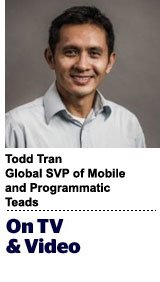 “On TV And Video” is a column exploring opportunities and challenges in programmatic TV and video.
“On TV And Video” is a column exploring opportunities and challenges in programmatic TV and video.
Today’s column is written by Todd Tran, global senior vice president of mobile and programmatic at Teads.
Programmatic is the Industrial Revolution of media. It has transformed the media industry, creating hundreds of ad tech companies with this seismic shift, along with plenty of unsavory elements, such as fraud, poor viewability and low-quality content.
As with any industry revolution, everyone realizes at some point that they are polluting the environment so badly that if they don’t clean up, they destroy themselves. The US and UK industrial revolutions led to the markets cleaning up and building long-term sustainable futures. China is in the middle of its industrial revolution and now must clean up.
Programmatic advertising has also reached that time. We need to think more proactively and strategically to build a long-term sustainable future for programmatic. I suggest we start by building a single quality score that measures each publisher and supply-side platform, the players that provide advertising inventory.
This is needed most in video advertising, which is increasingly made up of brand advertising but suffers from fraud, poor viewability and an opaque supply chain. This quality score has to be measured by a trusted third party with input from the industry on all sides.
The score should incorporate fraud. This has to be first and foremost. We don’t tolerate this in any other industry so it amazes me how much we have tolerated fraud in digital advertising, or perhaps we have simply turned a blind eye while riding the exciting momentum of growth. Fortunately, the industry has multiple fraud vendors now that detect fraud, which may be somehow incorporated into the score.
Another score factor: quality of context. ComScore’s recent study shows that ads within premium content generate better brand lift. This shouldn’t be surprising as consumers tend to truly read or watch premium content rather than gloss over it. There should be a score for the quality of the content by site or app. Since IAS and comScore measures this already, their scores can be incorporated.
User experience should also be scored. Forced views on video – nonskippable pre-roll – have boosted ad blocking but there are plenty of skippable video ads that work and reduce ad blocking. We need to measure the intrusiveness of a publishers’ ads and give the publishers a score.
Finally, viewability should factor into the score. More than 50% of all videos ads are not viewable. If a video ad is not viewable, it’s not worth anything.
We should have a scoreboard for each site and app with these scores that gets updated regularly for all to see. There should be an overall quality score that incorporates all these factors, along with individual scores of each metric. We need a trusted industry body to lead and own this.
This can be a big step in the transition to a long-term sustainable ecosystem for programmatic advertising that we can all be proud of.
Follow Teads (@Teads) and AdExchanger (@adexchanger) on Twitter.












